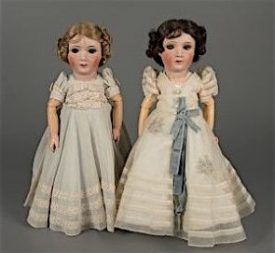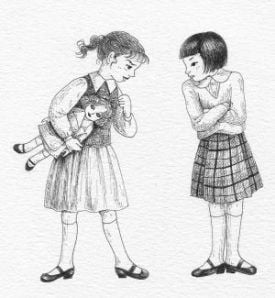#710 Four Strathcona princesses
The Princess Dolls
by Ellen Schwartz, with illustrations by Mariko Ando
Vancouver: Tradewind Books, 2018
$12.95 / 9781926890081
Reviewed by Michael Kluckner
*
 Best friends Esther and Michiko and their longing for two dolls of the English princesses, Elizabeth and Margaret, provide subjects for a wartime tale of friendship, racial injustice, and displacement set in Vancouver.
Best friends Esther and Michiko and their longing for two dolls of the English princesses, Elizabeth and Margaret, provide subjects for a wartime tale of friendship, racial injustice, and displacement set in Vancouver.
The Princess Dolls is Ellen Schwartz’s 17th children’s book, and it is a handsome one, smartly illustrated by Mariko Ando in pen-and-ink vignettes that run through the narrative like a river. There are stylish touches by designer Elisa Gutiérrez: a black spine that wraps around onto the front and back covers like an old fabric binding, red inside covers that mirror the colours of the girls’ jackets on the cover illustration, and, for each chapter title, a left-hand page of full-bleed black with a subtle white pattern reflecting the black-on-white illustration on the right-hand page.

The story is set in an unnamed part of Vancouver that is recognizably the Strathcona-Japantown (Powell Street) district. Esther is Jewish and it is through her eyes that the story unfolds; Michiko is Japanese Canadian. They are eight years old, in school and Girl Guides, still playing with dolls but old enough and responsible enough to look after Michiko’s little sister Akiko. Their friends are a mix of kids typical of that diverse working-class neighbourhood in the 1930s when it was, in historian John Atkin’s words, Vancouver’s only “League of Nations.”[1] (It was home to most of the city’s Jews at the time, as well as most other non-British immigrants). The only anomaly is a middle-class White girl named Florence, who competes to take Esther away from the other girls. Florence is a bit of a princess herself, with a father who works for the government in an unnamed but sinister capacity.
The story begins in January, 1942, a month after the Japanese attacks on Pearl Harbor and Hong Kong, with Esther, Michiko and their siblings walking to the Pantages Theatre on Hastings Street to see a movie. The girls have been dressing up and play-acting as Elizabeth and Margaret, and are stopped in their tracks by two beautiful dolls in a shop window:

Princess Elizabeth — it was her face exactly – wore tiny white gloves, shiny black pumps and a stylish powder-blue coat. Thick waves of real-looking brown hair curled around her porcelain face. A sparkling tiara crowned her head, and a faint smile tinged her red-painted lips.
Even though the dolls cost $15 each — a huge sum — the girls dream of getting them as presents on their shared birthday, February 7th. Into the narrative comes Esther’s grandmother Sadie from Toronto, who buys the Elizabeth doll for Esther. Michiko’s family, faced with uncertainty as anti-Japanese government regulations constrain their future and ruin their business, cannot buy the Margaret doll. The girls’ friendship goes to pieces, made worse when Florence gets the Margaret doll for her birthday.

Michiko’s parents are local shopkeepers while Esther’s very liberal father is the editor of a fictional newspaper called the Vancouver Messenger. As the story develops, the paper protests the increasing restrictions placed on coastal Japanese Canadians. Racist taunts from some neighbours and anti-Japanese newsreels at the cinema begin to cloud their happy lives. And Grandma Sadie introduces another piece of racial reality — Jewish relatives in Germany on the run from the Gestapo and the anxiety the family has about their whereabouts and safety.
The inter-racial aspect of the story is subtly told. Esther witnesses the trauma of uncertainty and displacement as the Japanese-Canadian children prepare themselves for evacuation and internment, and initially feels hurt that Michiko is excluding her. “The two of them had never made an issue of being Japanese or white or Christian or Jewish. They were just Esther and Michi. Best friends.” This is entirely plausible, children in that era or any other being colour-blind until indoctrinated by adult prejudices.

Later, when Esther worries that her father might lose his job over his anti-government opinions and be sent away, she wonders if what happened to Michiko might happen to her. She feels ashamed of herself, but admits it’s how she feels. To while away the time, she plays dolls with Florence until she becomes ashamed of that too. Princess Elizabeth goes back in her box in the closet until Esther decides to mail it to Michiko, her brother having received a mailing address from his pal, Michiko’s brother, in Kaslo.
Off the doll goes. Esther realizes that its shipment will take a while, having to pass through the postal system, government censors, and various other impediments, but frets as the weeks stretch into months and she gets no response. Then one day there’s a knock on the door. The postman has a package for her. Oh no! she thinks — Michiko has returned the doll. But when she opens it she finds a hand-made Princess Margaret doll from Michiko and a note of friendship and forgiveness.
It is entertaining to reflect on the idea — very true to the times — of little Commonwealth girls of whatever race enamoured of the English princesses whom they could never be, especially now when many of us have watched “The Crown” on Netflix or contemplated the lives of the naughty royals every time we stand in the check-out line at a supermarket (FYI: Elizabeth was 15 and Margaret 11 in 1941). My only criticism of the story is the lack of atmospheric writing, of even a little description of the neighbourhood of wooden houses, of smoking chimneys and foggy mornings, of winter rainstorms and girls in skirts and socks with their knees chilled red as they walked home from school. Perhaps that’s for the Adult Brain and not the target market, I don’t know.
Through school curriculum, the internment story will become familiar to children in Canada — how 22,000 people of Japanese ancestry living in coastal BC, three-quarters of whom were born in Canada, were stripped of their civil rights and property and interned in camps in the BC Interior. The Princess Dolls personalizes it and makes it accessible to children (certainly the girls who will be the majority of its readers) through this charming story.

*

Michael Kluckner is an author and illustrator who has written about the Japanese-Canadian internment in non-fiction books including Vanishing British Columbia and in the graphic novel Toshiko, set in the BC Interior with a teenaged Japanese-Canadian girl and a White farmhand providing romance and adventure. Toshiko will be released in a second edition in the Spring of 2020.
*
The Ormsby Review. More Books. More Reviews. More Often.
Publisher and Editor: Richard Mackie
The Ormsby Review is a journal service for serious coverage of B.C. books and authors, hosted by Simon Fraser University. The Advisory Board consists of Jean Barman, Robin Fisher, Cole Harris, Wade Davis, Hugh Johnston, Patricia Roy, David Stouck, and Graeme Wynn. Scholarly Patron: SFU Graduate Liberal Studies. Honorary Patron: Yosef Wosk. Provincial Government Patron since September 2018: Creative BC
“Only connect.” – E.M. Forster
Notes:
[1] John Atlin, Strathcona: Vancouver’s First Neighbourhood (Vancouver: Whitecap, 1994).

One comment on “#710 Four Strathcona princesses”
Comments are closed.